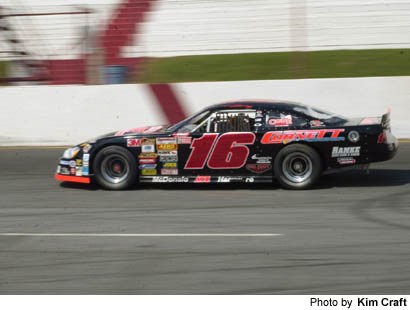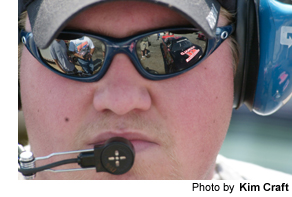
June 26, 2001 — Tom Hardy was shouting. He wasn’t angry. Shouting just happens to be the main form of communication at Lanier National Speedway on Saturday nights.
No, Hardy wasn’t upset. But less than an hour before the green flag was set to drop on his race at the Braselton track, Hardy hardly appeared comfortable.
“I’m confused,” the popular Pro Late Model driver yelled over the clamor of cars — his race, the feature race, was the last on the evening’s schedule. “The first of the year, we ran really good. We’ve been kind of struggling here lately. We’re not terrible, but we aren’t where we are used to being.
“I’m just trying to think if there’s something I overlooked.”
The day hadn’t given Hardy much to go on, and I certainly wasn’t going to be any help. I was technically a member of Hardy’s pit crew for his NASCAR Weekly Racing Series 50-lap points race on Saturday, but early on in my apprenticeship it became apparent to me — and likely everyone else I came in contact with — that the team would be best served if I simply tried to stay out of the way.
So I fetched the odd wrench and did a lot of standing around. Based on our results that night, I didn’t even do that very well.
“What are your thoughts?” Hardy asked me — jokingly, I assume — as race time approached. “Everybody else is giving me theirs.”
I had nothing to offer. Not even a wrench.
Through the afternoon “hot laps” and the early-evening qualifying session, the performance of Hardy’s black No. 16 Ford Taurus stock car was consistently “so-so,” in his own repeated words.
Still, Hardy posted the fifth-fastest qualifying lap out of the field of 16 cars, and likely would have been even closer to the pole had he not spent the final straightaway of his first lap pointed sideways. A true “bonzai run,” Hardy said.
(“I told him that he needed to drive it a little harder,” crew member Bryan Berrong explained afterward. “Maybe he drove it a little too hard.”)
So Hardy settled for fifth in qualifying. Far from terrible, to be sure. But not up to the high standards of a three-time track champion.
“I’m hard to please,” said Hardy, 37, of Jefferson, winner of Lanier’s crown in 1994, ’96 and ’99.
This season, which began in late March and runs through September, Hardy is one of six drivers to win a Pro Late Model race at Lanier. He held the lead in the points standings until two weeks ago, when the race team began to struggle.
 “We’ve been off,” Vince Hardy, the driver’s 21-year-old son, said bluntly. “Bad off.”
“We’ve been off,” Vince Hardy, the driver’s 21-year-old son, said bluntly. “Bad off.”
But Thursday’s practice session was promising, and drivers like Tom Hardy always bounce back eventually. Going into Saturday, the crew was upbeat.
“He could be the next track champion if he’d just get in the car and drive it,” crew chief Vickie Thomas, of Pendergrass, said after Saturday’s qualifying. “I think he’s got really good chances tonight. If he puts his foot in it, he’ll do good.”
Hardy grew up around racing. He was the type of kid who was riding motorcycles before bicycles. No lie.
He began racing at Lanier as a 28-year-old in 1993. One year later, he was track champion.
Since then, he has built quite a large local fanbase. He is routinely recognized at restaurants. Children often ask for his autograph.
Thanks in part to his popularity, Hardy has managed to obtain several key sponsorships — a necessity in the sport, even on the local level.
Most drivers fight to break even. A top-five finish means you can pay your tire bill that week.
Like many other local drivers, Hardy began racing with aspirations of following in the footsteps of the Bill Elliotts of the world.
“It’s kind of the American dream,” said Hardy, part-owner of a used car dealership in Commerce. “But I’m 37. Time’s probably passed me by as far as making it to Winston Cup or Busch. You do it because you enjoy it.”
Same goes for the members of the pit crew. All volunteers, they showed up early Saturday afternoon for a race that wasn’t scheduled to begin until after 9 p.m.
“It’s like a drug,” crew member Len Hardy (no relation) said. “It just gets in your blood. I’ve tried to quit. I can’t seem to do it.”
After each hot lap, each qualifying run, Tom Hardy’s crew — which numbered seven (not including me, of course) — would rush to the car and tend to it like a team of emergency technicians. Tires were measured in circumference, temperature and air pressure, then measured again.
Hardy himself would often grab a wrench — or, on special occasions, I would hand one to him — and crawl underneath to make some adjustments.
All day long, the “stagger” on the rear tires — the difference in circumference between the inside and outside tires — wasn’t to Hardy’s liking. The car hadn’t been turning cleanly, and Hardy fiddled with it right up to race time.
Proper stagger or no, Hardy’s car was one of the prettiest on the track. And I’d say the crew, with our matching embroidered black shirts, was one of the best dressed. Vince Hardy, who grew up waxing his father’s race cars (often repeatedly), said appearances have always been important to Tom Hardy.
Most of the pit crew’s collective energy was spent during the hours leading up to the race. During 50 laps, on an oval track just 3/8-mile long, pit stops generally aren’t necessary. And if one is, it’s probably a bad sign. I say this for a reason.
During the race, I stood in the infield on top of Hardy’s trailer with a headset on. I did pirouettes, following the black No. 16 car around and around.
Hardy later said he could tell something wasn’t right on the race’s first turn, but it took 10 laps for three cars to pass him.
“Find that rhythm. Find that rhythm,” Vince Hardy said to his father through his headset.
The rhythm never came. Hardy drifted farther back in the pack.
“What’s wrong with it?” Berrong asked frantically through the radio.
“I think we’ve got the air pressure too low in the back tires,” Tom Hardy replied.
“Well, we can’t hardly go back no further,” Berrong said. “There ain’t no sense of you staying out there.”
Hardy hurriedly pulled into the pits on the next caution. Berrong adjusted the air pressure, but the damage was done. Hardy was in last place, a third of the race complete.
Caution lifted, Hardy passed two cars. Then another. And another. He eventually landed in 11th place, where he would remain.
“Rough day at the office,” Hardy said, still stopping to sign his share of post-race autographs. “But if you don’t have the bad, you can’t appreciate the good.”
